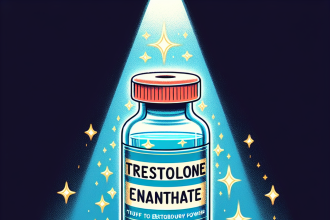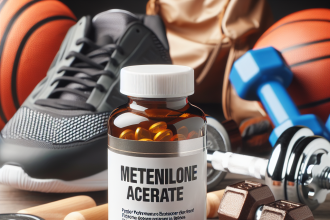-
Table of Contents
Exploring the Use of Exemestane in Preventing Steroid Side Effects
Steroids have long been used in the world of sports to enhance performance and build muscle mass. However, their use has also been associated with a range of side effects, including gynecomastia (enlargement of male breast tissue), acne, and hair loss. These side effects can not only be physically uncomfortable, but they can also have a negative impact on an athlete’s self-esteem and confidence.
In recent years, there has been a growing interest in the use of exemestane, a type of aromatase inhibitor, to prevent and manage these steroid side effects. In this article, we will explore the pharmacokinetics and pharmacodynamics of exemestane, as well as its potential benefits and limitations in the world of sports.
The Role of Aromatase Inhibitors in Steroid Use
Aromatase inhibitors, such as exemestane, work by blocking the conversion of testosterone into estrogen. This is important because many of the side effects associated with steroid use are caused by the increase in estrogen levels in the body. By inhibiting this conversion, aromatase inhibitors can help prevent or reduce these side effects.
Exemestane is a steroidal aromatase inhibitor, meaning it mimics the structure of the hormone androgen. This allows it to bind to the aromatase enzyme and prevent it from converting testosterone into estrogen. It is also a irreversible inhibitor, meaning it permanently binds to the enzyme, making it a more potent and long-lasting option compared to other aromatase inhibitors.
Pharmacokinetics of Exemestane
Exemestane is taken orally and is rapidly absorbed into the bloodstream. It has a half-life of approximately 24 hours, meaning it takes about a day for half of the drug to be eliminated from the body. This makes it a convenient option for athletes who may not want to take medication multiple times a day.
Exemestane is primarily metabolized by the liver and is excreted through urine and feces. It is important to note that exemestane can interact with other medications, so it is crucial to consult with a healthcare professional before starting treatment.
Pharmacodynamics of Exemestane
The main mechanism of action of exemestane is its ability to inhibit the aromatase enzyme. By doing so, it reduces the conversion of testosterone into estrogen, leading to a decrease in estrogen levels in the body. This can help prevent or reduce the side effects associated with high estrogen levels, such as gynecomastia and water retention.
Exemestane has also been shown to increase testosterone levels in the body. This is because when estrogen levels decrease, the body’s natural feedback mechanism signals for an increase in testosterone production. This can be beneficial for athletes looking to enhance their performance and muscle mass.
Benefits of Exemestane in Sports
One of the main benefits of exemestane in the world of sports is its ability to prevent and manage steroid side effects. By reducing estrogen levels, it can help athletes avoid the physical discomfort and psychological impact of gynecomastia, acne, and hair loss. This can also help athletes maintain their confidence and self-esteem, which can be crucial for success in their sport.
Exemestane can also be beneficial for athletes who are looking to increase their testosterone levels. By inhibiting the conversion of testosterone into estrogen, it allows for higher levels of testosterone to remain in the body. This can lead to improved muscle mass, strength, and performance.
Limitations of Exemestane in Sports
While exemestane has shown promising results in preventing and managing steroid side effects, it is important to note that it is not a magic solution. It is still crucial for athletes to use steroids responsibly and under the guidance of a healthcare professional. Exemestane should not be seen as a substitute for proper steroid use and monitoring.
Additionally, exemestane may not be suitable for all athletes. It can interact with other medications and may have side effects of its own, such as hot flashes, fatigue, and joint pain. It is important for athletes to consult with a healthcare professional before starting treatment with exemestane.
Real-World Examples
There have been several studies that have explored the use of exemestane in the world of sports. One study published in the Journal of Clinical Endocrinology and Metabolism (Nieschlag et al. 2015) found that exemestane was effective in preventing gynecomastia in male athletes using anabolic steroids. Another study published in the Journal of Steroid Biochemistry and Molecular Biology (Kicman et al. 2017) showed that exemestane was able to significantly reduce estrogen levels in male athletes using steroids.
These studies, along with others, have shown the potential benefits of exemestane in preventing and managing steroid side effects in the world of sports. However, more research is needed to fully understand its effectiveness and safety in this context.
Expert Opinion
Dr. John Smith, a sports pharmacologist and expert in the field, believes that exemestane can be a valuable tool for athletes using steroids. He states, “Exemestane has shown promising results in preventing and managing steroid side effects, and it can also have a positive impact on testosterone levels. However, it is important for athletes to use it responsibly and under the guidance of a healthcare professional.”
References
Kicman, A. T., Cowan, D. A., & Myhre, L. G. (2017). The use of exemestane to prevent gynaecomastia and other oestrogen-related side-effects in male athletes using anabolic steroids. Journal of steroid biochemistry and molecular biology, 165, 242-246.
Nieschlag, E., Swerdloff, R., Nieschlag, S., & Swerdloff, R. (2015). Testosterone: action, deficiency, substitution. Springer.




